ECO mode JEEP WRANGLER UNLIMITED 2020 Owner handbook (in English)
[x] Cancel search | Manufacturer: JEEP, Model Year: 2020, Model line: WRANGLER UNLIMITED, Model: JEEP WRANGLER UNLIMITED 2020Pages: 330, PDF Size: 9.16 MB
Page 83 of 330
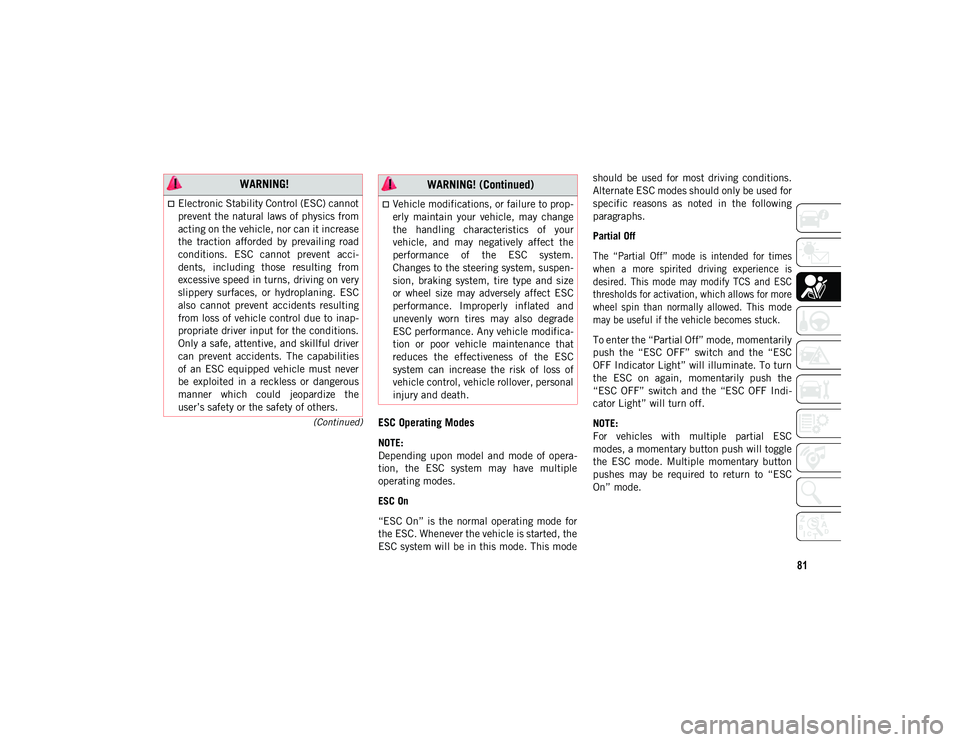
81
(Continued)ESC Operating Modes
NOTE:
Depending upon model and mode of opera-
tion, the ESC system may have multiple
operating modes.
ESC On
ŌĆ£ESC OnŌĆØ is the normal operating mode for
the ESC. Whenever the vehicle is started, the
ESC system will be in this mode. This mode should be used for most driving conditions.
Alternate ESC modes should only be used for
specific reasons as noted in the following
paragraphs.
Partial Off
The ŌĆ£Partial OffŌĆØ mode is intended for times
when a more spirited driving experience is
desired. This mode may modify TCS and ESC
thresholds for activation, which allows for more
wheel spin than normally allowed. This mode
may be useful if the vehicle becomes stuck.
To enter the ŌĆ£Partial OffŌĆØ mode, momentarily
push the ŌĆ£ESC OFFŌĆØ switch and the ŌĆ£ESC
OFF Indicator LightŌĆØ will illuminate. To turn
the ESC on again, momentarily push the
ŌĆ£ESC OFFŌĆØ switch and the ŌĆ£ESC OFF Indi
-
cator LightŌĆØ will turn off.
NOTE:
For vehicles with multiple partial ESC
modes, a momentary button push will toggle
the ESC mode. Multiple momentary button
pushes may be required to return to ŌĆ£ESC
OnŌĆØ mode.
WARNING!
’ü»Electronic Stability Control (ESC) cannot
prevent the natural laws of physics from
acting on the vehicle, nor can it increase
the traction afforded by prevailing road
conditions. ESC cannot prevent acci -
dents, including those resulting from
excessive speed in turns, driving on very
slippery surfaces, or hydroplaning. ESC
also cannot prevent accidents resulting
from loss of vehicle control due to inap -
propriate driver input for the conditions.
Only a safe, attentive, and skillful driver
can prevent accidents. The capabilities
of an ESC equipped vehicle must never
be exploited in a reckless or dangerous
manner which could jeopardize the
userŌĆÖs safety or the safety of others.’ü»Vehicle modifications, or failure to prop -
erly maintain your vehicle, may change
the handling characteristics of your
vehicle, and may negatively affect the
performance of the ESC system.
Changes to the steering system, suspen -
sion, braking system, tire type and size
or wheel size may adversely affect ESC
performance. Improperly inflated and
unevenly worn tires may also degrade
ESC performance. Any vehicle modifica-
tion or poor vehicle maintenance that
reduces the effectiveness of the ESC
system can increase the risk of loss of
vehicle control, vehicle rollover, personal
injury and death.
WARNING! (Continued)
2020_JEEP_JL_WRANGLER_UG_RHD_UK.book Page 81
Page 84 of 330
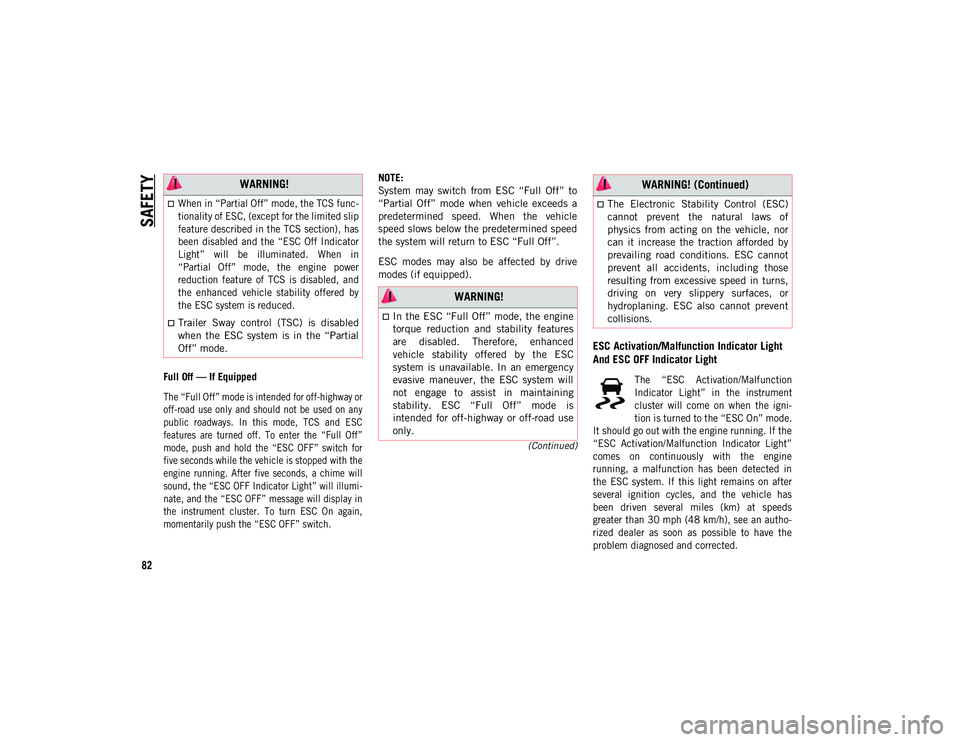
SAFETY
82
(Continued)
Full Off ŌĆö If Equipped
The ŌĆ£Full OffŌĆØ mode is intended for off-highway or
off-road use only and should not be used on any
public roadways. In this mode, TCS and ESC
features are turned off. To enter the ŌĆ£Full OffŌĆØ
mode, push and hold the ŌĆ£ESC OFFŌĆØ switch for
five seconds while the vehicle is stopped with the
engine running. After five seconds, a chime will
sound, the ŌĆ£ESC OFF Indicator LightŌĆØ will illumi-
nate, and the ŌĆ£ESC OFFŌĆØ message will display in
the instrument cluster. To turn ESC On again,
momentarily push the ŌĆ£ESC OFFŌĆØ switch.
NOTE:
System may switch from ESC ŌĆ£Full OffŌĆØ to
ŌĆ£Partial OffŌĆØ mode when vehicle exceeds a
predetermined speed. When the vehicle
speed slows below the predetermined speed
the system will return to ESC ŌĆ£Full OffŌĆØ.
ESC modes may also be affected by drive
modes (if equipped).
ESC Activation/Malfunction Indicator Light
And ESC OFF Indicator Light
The ŌĆ£ESC Activation/Malfunction
Indicator LightŌĆØ in the instrument
cluster will come on when the igni
-
tion is turned to the ŌĆ£ESC OnŌĆØ mode.
It should go out with the engine running. If the
ŌĆ£ESC Activation/Malfunction Indicator LightŌĆØ
comes on continuously with the engine
running, a malfunction has been detected in
the ESC system. If this light remains on after
several ignition cycles, and the vehicle has
been driven several miles (km) at speeds
greater than 30 mph (48 km/h), see an autho -
rized dealer as soon as possible to have the
problem diagnosed and corrected.
WARNING!
’ü»When in ŌĆ£Partial OffŌĆØ mode, the TCS func -
tionality of ESC, (except for the limited slip
feature described in the TCS section), has
been disabled and the ŌĆ£ESC Off Indicator
LightŌĆØ will be illuminated. When in
ŌĆ£Partial OffŌĆØ mode, the engine power
reduction feature of TCS is disabled, and
the enhanced vehicle stability offered by
the ESC system is reduced.
’ü»Trailer Sway control (TSC) is disabled
when the ESC system is in the ŌĆ£Partial
OffŌĆØ mode.
WARNING!
’ü»In the ESC ŌĆ£Full OffŌĆØ mode, the engine
torque reduction and stability features
are disabled. Therefore, enhanced
vehicle stability offered by the ESC
system is unavailable. In an emergency
evasive maneuver, the ESC system will
not engage to assist in maintaining
stability. ESC ŌĆ£Full OffŌĆØ mode is
intended for off-highway or off-road use
only.
’ü»The Electronic Stability Control (ESC)
cannot prevent the natural laws of
physics from acting on the vehicle, nor
can it increase the traction afforded by
prevailing road conditions. ESC cannot
prevent all accidents, including those
resulting from excessive speed in turns,
driving on very slippery surfaces, or
hydroplaning. ESC also cannot prevent
collisions.
WARNING! (Continued)
2020_JEEP_JL_WRANGLER_UG_RHD_UK.book Page 82
Page 85 of 330
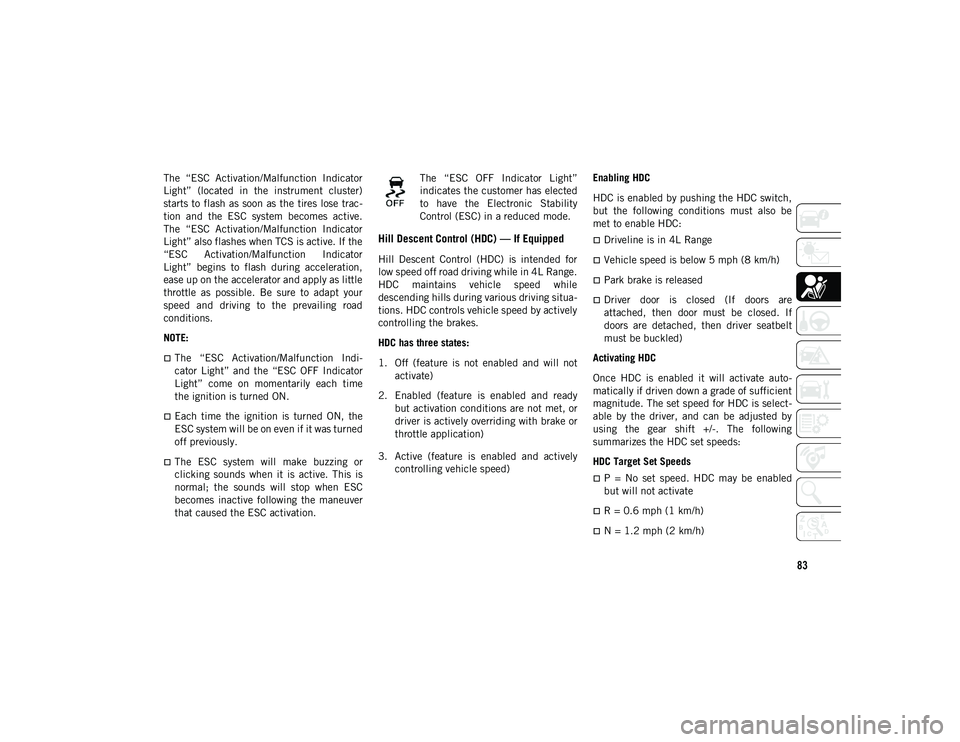
83
The ŌĆ£ESC Activation/Malfunction Indicator
LightŌĆØ (located in the instrument cluster)
starts to flash as soon as the tires lose trac-
tion and the ESC system becomes active.
The ŌĆ£ESC Activation/Malfunction Indicator
LightŌĆØ also flashes when TCS is active. If the
ŌĆ£ESC Activation/Malfunction Indicator
LightŌĆØ begins to flash during acceleration,
ease up on the accelerator and apply as little
throttle as possible. Be sure to adapt your
speed and driving to the prevailing road
conditions.
NOTE:
’ü»The ŌĆ£ESC Activation/Malfunction Indi -
cator LightŌĆØ and the ŌĆ£ESC OFF Indicator
LightŌĆØ come on momentarily each time
the ignition is turned ON.
’ü»Each time the ignition is turned ON, the
ESC system will be on even if it was turned
off previously.
’ü»The ESC system will make buzzing or
clicking sounds when it is active. This is
normal; the sounds will stop when ESC
becomes inactive following the maneuver
that caused the ESC activation. The ŌĆ£ESC OFF Indicator LightŌĆØ
indicates the customer has elected
to have the Electronic Stability
Control (ESC) in a reduced mode.
Hill Descent Control (HDC) ŌĆö If Equipped
Hill Descent Control (HDC) is intended for
low speed off road driving while in 4L Range.
HDC maintains vehicle speed while
descending hills during various driving situa
-
tions. HDC controls vehicle speed by actively
controlling the brakes.
HDC has three states:
1. Off (feature is not enabled and will not activate)
2. Enabled (feature is enabled and ready but activation conditions are not met, or
driver is actively overriding with brake or
throttle application)
3. Active (feature is enabled and actively controlling vehicle speed) Enabling HDC
HDC is enabled by pushing the HDC switch,
but the following conditions must also be
met to enable HDC:
’ü»Driveline is in 4L Range
’ü»Vehicle speed is below 5 mph (8 km/h)
’ü»Park brake is released
’ü»Driver door is closed (If doors are
attached, then door must be closed. If
doors are detached, then driver seatbelt
must be buckled)
Activating HDC
Once HDC is enabled it will activate auto -
matically if driven down a grade of sufficient
magnitude. The set speed for HDC is select -
able by the driver, and can be adjusted by
using the gear shift +/-. The following
summarizes the HDC set speeds:
HDC Target Set Speeds
’ü»P = No set speed. HDC may be enabled
but will not activate
’ü»R = 0.6 mph (1 km/h)
’ü»N = 1.2 mph (2 km/h)
2020_JEEP_JL_WRANGLER_UG_RHD_UK.book Page 83
Page 88 of 330
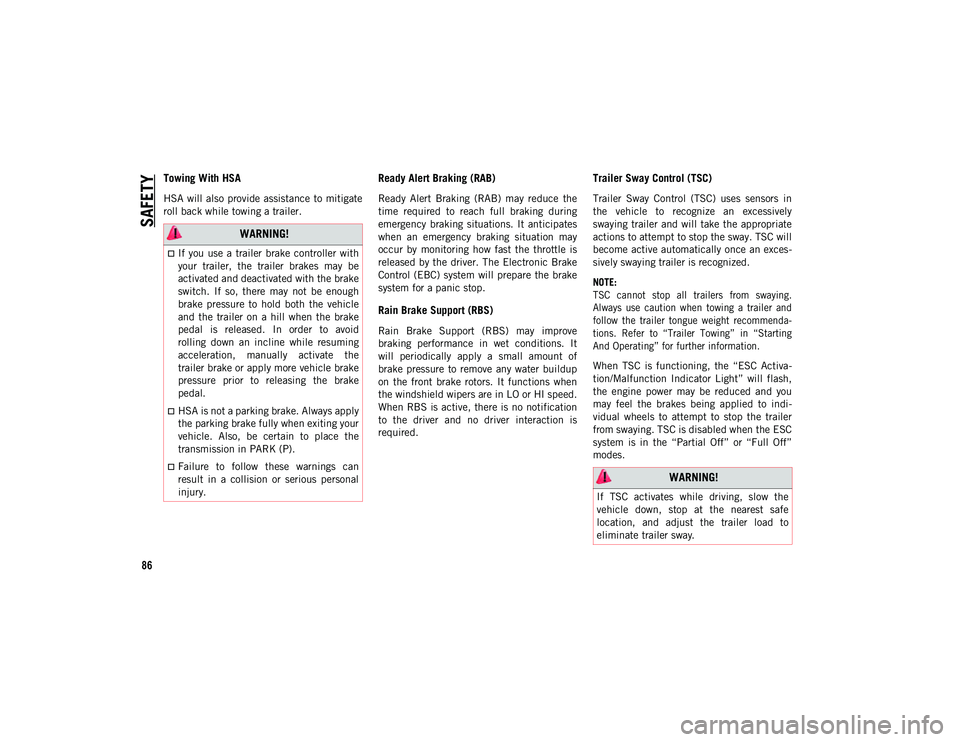
SAFETY
86
Towing With HSA
HSA will also provide assistance to mitigate
roll back while towing a trailer.
Ready Alert Braking (RAB)
Ready Alert Braking (RAB) may reduce the
time required to reach full braking during
emergency braking situations. It anticipates
when an emergency braking situation may
occur by monitoring how fast the throttle is
released by the driver. The Electronic Brake
Control (EBC) system will prepare the brake
system for a panic stop.
Rain Brake Support (RBS)
Rain Brake Support (RBS) may improve
braking performance in wet conditions. It
will periodically apply a small amount of
brake pressure to remove any water buildup
on the front brake rotors. It functions when
the windshield wipers are in LO or HI speed.
When RBS is active, there is no notification
to the driver and no driver interaction is
required.
Trailer Sway Control (TSC)
Trailer Sway Control (TSC) uses sensors in
the vehicle to recognize an excessively
swaying trailer and will take the appropriate
actions to attempt to stop the sway. TSC will
become active automatically once an exces-
sively swaying trailer is recognized.
NOTE:
TSC cannot stop all trailers from swaying.
Always use caution when towing a trailer and
follow the trailer tongue weight recommenda-
tions. Refer to ŌĆ£Trailer TowingŌĆØ in ŌĆ£Starting
And OperatingŌĆØ for further information.
When TSC is functioning, the ŌĆ£ESC Activa -
tion/Malfunction Indicator LightŌĆØ will flash,
the engine power may be reduced and you
may feel the brakes being applied to indi -
vidual wheels to attempt to stop the trailer
from swaying. TSC is disabled when the ESC
system is in the ŌĆ£Partial OffŌĆØ or ŌĆ£Full OffŌĆØ
modes.
WARNING!
’ü»If you use a trailer brake controller with
your trailer, the trailer brakes may be
activated and deactivated with the brake
switch. If so, there may not be enough
brake pressure to hold both the vehicle
and the trailer on a hill when the brake
pedal is released. In order to avoid
rolling down an incline while resuming
acceleration, manually activate the
trailer brake or apply more vehicle brake
pressure prior to releasing the brake
pedal.
’ü»HSA is not a parking brake. Always apply
the parking brake fully when exiting your
vehicle. Also, be certain to place the
transmission in PARK (P).
’ü»Failure to follow these warnings can
result in a collision or serious personal
injury. WARNING!
If TSC activates while driving, slow the
vehicle down, stop at the nearest safe
location, and adjust the trailer load to
eliminate trailer sway.
2020_JEEP_JL_WRANGLER_UG_RHD_UK.book Page 86
Page 89 of 330
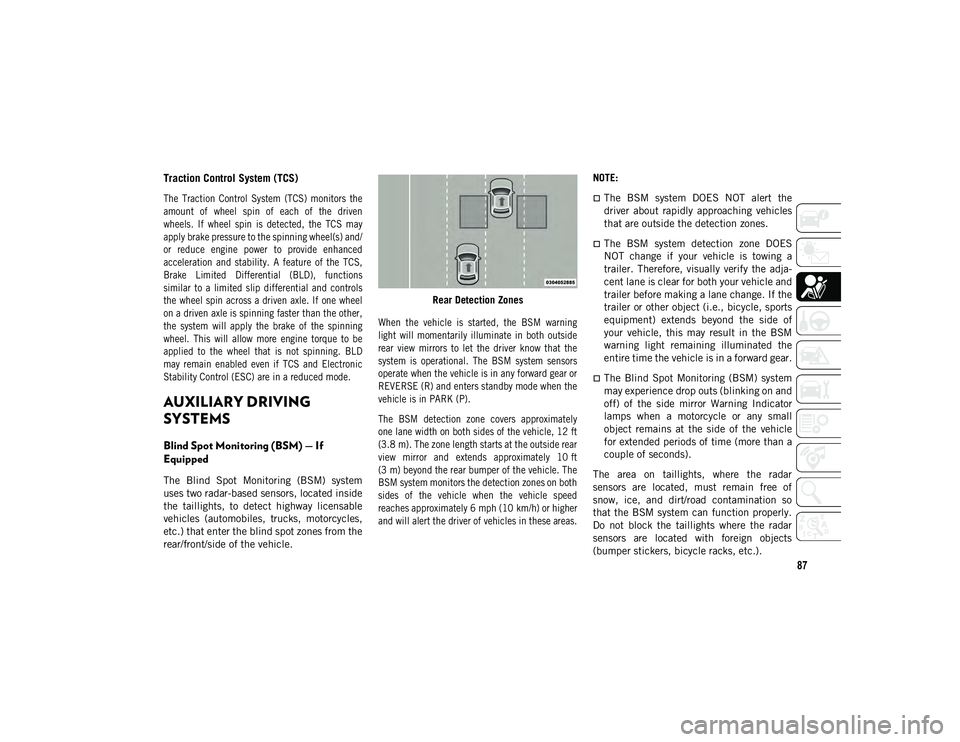
87
Traction Control System (TCS)
The Traction Control System (TCS) monitors the
amount of wheel spin of each of the driven
wheels. If wheel spin is detected, the TCS may
apply brake pressure to the spinning wheel(s) and/
or reduce engine power to provide enhanced
acceleration and stability. A feature of the TCS,
Brake Limited Differential (BLD), functions
similar to a limited slip differential and controls
the wheel spin across a driven axle. If one wheel
on a driven axle is spinning faster than the other,
the system will apply the brake of the spinning
wheel. This will allow more engine torque to be
applied to the wheel that is not spinning. BLD
may remain enabled even if TCS and Electronic
Stability Control (ESC) are in a reduced mode.
AUXILIARY DRIVING
SYSTEMS
Blind Spot Monitoring (BSM) ŌĆö If
Equipped
The Blind Spot Monitoring (BSM) system
uses two radar-based sensors, located inside
the taillights, to detect highway licensable
vehicles (automobiles, trucks, motorcycles,
etc.) that enter the blind spot zones from the
rear/front/side of the vehicle.Rear Detection Zones
When the vehicle is started, the BSM warning
light will momentarily illuminate in both outside
rear view mirrors to let the driver know that the
system is operational. The BSM system sensors
operate when the vehicle is in any forward gear or
REVERSE (R) and enters standby mode when the
vehicle is in PARK (P).
The BSM detection zone covers approximately
one lane width on both sides of the vehicle, 12 ft
(3.8 m). The zone length starts at the outside rear
view mirror and extends approximately 10 ft
(3 m) beyond the rear bumper of the vehicle. The
BSM system monitors the detection zones on both
sides of the vehicle when the vehicle speed
reaches approximately 6 mph (10 km/h) or higher and will alert the driver of vehicles in these areas.
NOTE:
’ü»The BSM system DOES NOT alert the
driver about rapidly approaching vehicles
that are outside the detection zones.
’ü»The BSM system detection zone DOES
NOT change if your vehicle is towing a
trailer. Therefore, visually verify the adja-
cent lane is clear for both your vehicle and
trailer before making a lane change. If the
trailer or other object (i.e., bicycle, sports
equipment) extends beyond the side of
your vehicle, this may result in the BSM
warning light remaining illuminated the
entire time the vehicle is in a forward gear.
’ü»The Blind Spot Monitoring (BSM) system
may experience drop outs (blinking on and
off) of the side mirror Warning Indicator
lamps when a motorcycle or any small
object remains at the side of the vehicle
for extended periods of time (more than a
couple of seconds).
The area on taillights, where the radar
sensors are located, must remain free of
snow, ice, and dirt/road contamination so
that the BSM system can function properly.
Do not block the taillights where the radar
sensors are located with foreign objects
(bumper stickers, bicycle racks, etc.).
2020_JEEP_JL_WRANGLER_UG_RHD_UK.book Page 87
Page 90 of 330
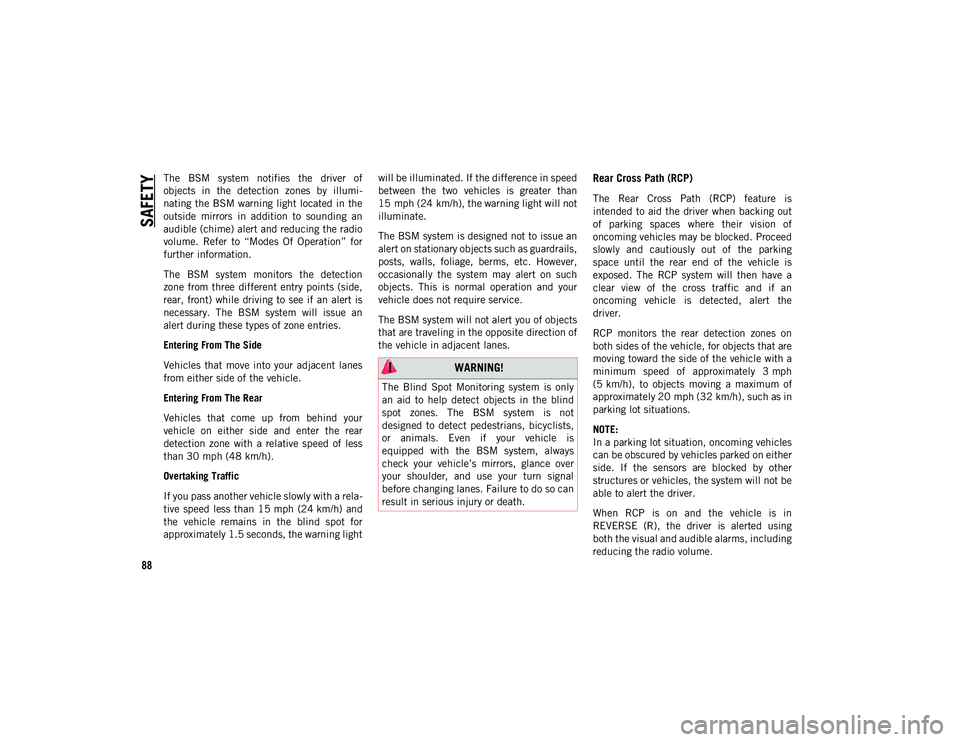
SAFETY
88
The BSM system notifies the driver of
objects in the detection zones by illumi-
nating the BSM warning light located in the
outside mirrors in addition to sounding an
audible (chime) alert and reducing the radio
volume. Refer to ŌĆ£Modes Of OperationŌĆØ for
further information.
The BSM system monitors the detection
zone from three different entry points (side,
rear, front) while driving to see if an alert is
necessary. The BSM system will issue an
alert during these types of zone entries.
Entering From The Side
Vehicles that move into your adjacent lanes
from either side of the vehicle.
Entering From The Rear
Vehicles that come up from behind your
vehicle on either side and enter the rear
detection zone with a relative speed of less
than 30 mph (48 km/h).
Overtaking Traffic
If you pass another vehicle slowly with a rela -
tive speed less than 15 mph (24 km/h) and
the vehicle remains in the blind spot for
approximately 1.5 seconds, the warning light will be illuminated. If the difference in speed
between the two vehicles is greater than
15 mph (24 km/h), the warning light will not
illuminate.
The BSM system is designed not to issue an
alert on stationary objects such as guardrails,
posts, walls, foliage, berms, etc. However,
occasionally the system may alert on such
objects. This is normal operation and your
vehicle does not require service.
The BSM system will not alert you of objects
that are traveling in the opposite direction of
the vehicle in adjacent lanes.Rear Cross Path (RCP)
The Rear Cross Path (RCP) feature is
intended to aid the driver when backing out
of parking spaces where their vision of
oncoming vehicles may be blocked. Proceed
slowly and cautiously out of the parking
space until the rear end of the vehicle is
exposed. The RCP system will then have a
clear view of the cross traffic and if an
oncoming vehicle is detected, alert the
driver.
RCP monitors the rear detection zones on
both sides of the vehicle, for objects that are
moving toward the side of the vehicle with a
minimum speed of approximately 3 mph
(5 km/h), to objects moving a maximum of
approximately 20 mph (32 km/h), such as in
parking lot situations.
NOTE:
In a parking lot situation, oncoming vehicles
can be obscured by vehicles parked on either
side. If the sensors are blocked by other
structures or vehicles, the system will not be
able to alert the driver.
When RCP is on and the vehicle is in
REVERSE (R), the driver is alerted using
both the visual and audible alarms, including
reducing the radio volume.
WARNING!
The Blind Spot Monitoring system is only
an aid to help detect objects in the blind
spot zones. The BSM system is not
designed to detect pedestrians, bicyclists,
or animals. Even if your vehicle is
equipped with the BSM system, always
check your vehicleŌĆÖs mirrors, glance over
your shoulder, and use your turn signal
before changing lanes. Failure to do so can
result in serious injury or death.
2020_JEEP_JL_WRANGLER_UG_RHD_UK.book Page 88
Page 99 of 330
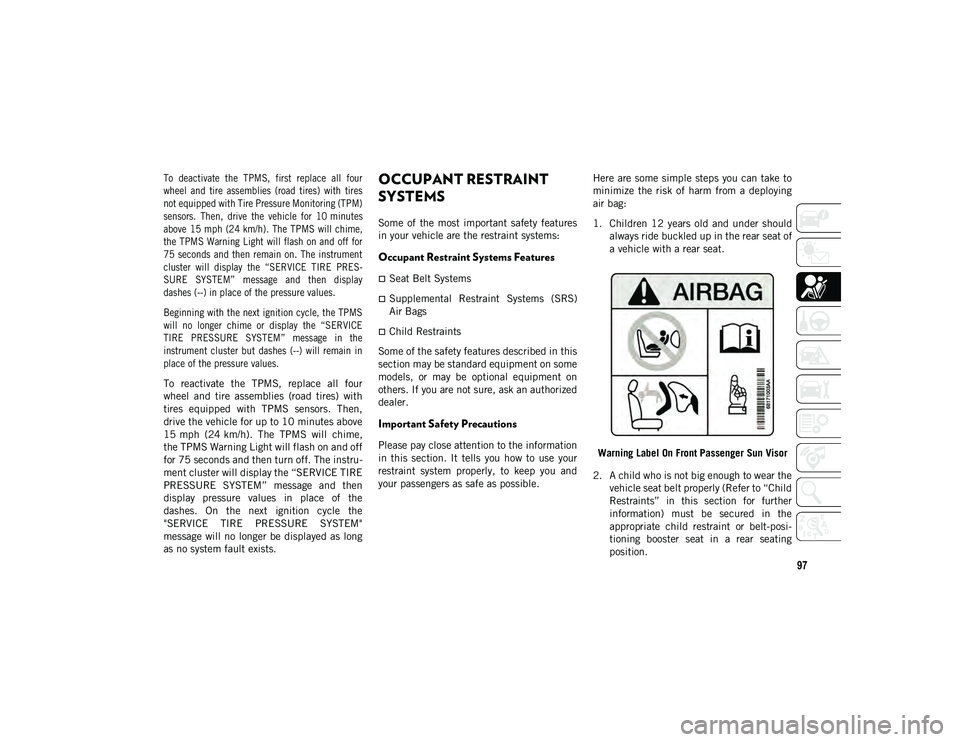
97
To deactivate the TPMS, first replace all four
wheel and tire assemblies (road tires) with tires
not equipped with Tire Pressure Monitoring (TPM)
sensors. Then, drive the vehicle for 10 minutes
above 15 mph (24 km/h). The TPMS will chime,
the TPMS Warning Light will flash on and off for
75 seconds and then remain on. The instrument
cluster will display the ŌĆ£SERVICE TIRE PRES-
SURE SYSTEMŌĆØ message and then display
dashes (--) in place of the pressure values.
Beginning with the next ignition cycle, the TPMS
will no longer chime or display the ŌĆ£SERVICE
TIRE PRESSURE SYSTEMŌĆØ message in the
instrument cluster but dashes (--) will remain in
place of the pressure values.
To reactivate the TPMS, replace all four
wheel and tire assemblies (road tires) with
tires equipped with TPMS sensors. Then,
drive the vehicle for up to 10 minutes above
15 mph (24 km/h). The TPMS will chime,
the TPMS Warning Light will flash on and off
for 75 seconds and then turn off. The instru -
ment cluster will display the ŌĆ£SERVICE TIRE
PRESSURE SYSTEMŌĆØ message and then
display pressure values in place of the
dashes. On the next ignition cycle the
"SERVICE TIRE PRESSURE SYSTEM"
message will no longer be displayed as long
as no system fault exists.OCCUPANT RESTRAINT
SYSTEMS
Some of the most important safety features
in your vehicle are the restraint systems:
Occupant Restraint Systems Features
’ü»Seat Belt Systems
’ü»Supplemental Restraint Systems (SRS)
Air Bags
’ü»Child Restraints
Some of the safety features described in this
section may be standard equipment on some
models, or may be optional equipment on
others. If you are not sure, ask an authorized
dealer.
Important Safety Precautions
Please pay close attention to the information
in this section. It tells you how to use your
restraint system properly, to keep you and
your passengers as safe as possible. Here are some simple steps you can take to
minimize the risk of harm from a deploying
air bag:
1. Children 12 years old and under should
always ride buckled up in the rear seat of
a vehicle with a rear seat.
Warning Label On Front Passenger Sun Visor
2. A child who is not big enough to wear the vehicle seat belt properly (Refer to ŌĆ£Child
RestraintsŌĆØ in this section for further
information) must be secured in the
appropriate child restraint or belt-posi -
tioning booster seat in a rear seating
position.
2020_JEEP_JL_WRANGLER_UG_RHD_UK.book Page 97
Page 138 of 330
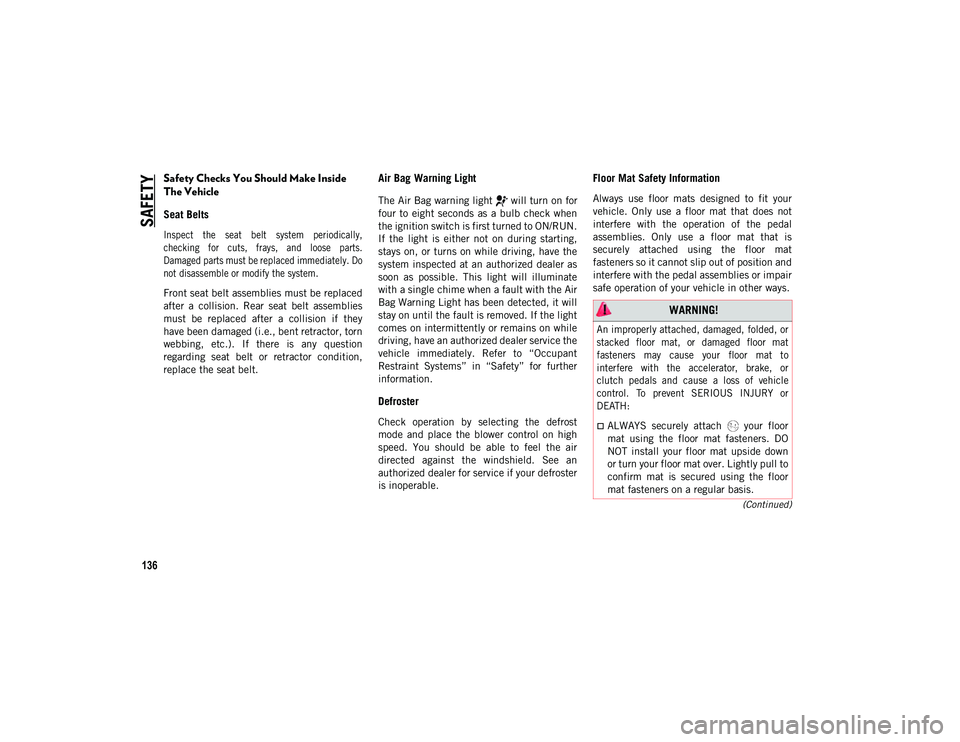
SAFETY
136
(Continued)
Safety Checks You Should Make Inside
The Vehicle
Seat Belts
Inspect the seat belt system periodically,
checking for cuts, frays, and loose parts.
Damaged parts must be replaced immediately. Do
not disassemble or modify the system.
Front seat belt assemblies must be replaced
after a collision. Rear seat belt assemblies
must be replaced after a collision if they
have been damaged (i.e., bent retractor, torn
webbing, etc.). If there is any question
regarding seat belt or retractor condition,
replace the seat belt.
Air Bag Warning Light
The Air Bag warning light will turn on for
four to eight seconds as a bulb check when
the ignition switch is first turned to ON/RUN.
If the light is either not on during starting,
stays on, or turns on while driving, have the
system inspected at an authorized dealer as
soon as possible. This light will illuminate
with a single chime when a fault with the Air
Bag Warning Light has been detected, it will
stay on until the fault is removed. If the light
comes on intermittently or remains on while
driving, have an authorized dealer service the
vehicle immediately. Refer to ŌĆ£Occupant
Restraint SystemsŌĆØ in ŌĆ£SafetyŌĆØ for further
information.
Defroster
Check operation by selecting the defrost
mode and place the blower control on high
speed. You should be able to feel the air
directed against the windshield. See an
authorized dealer for service if your defroster
is inoperable.
Floor Mat Safety Information
Always use floor mats designed to fit your
vehicle. Only use a floor mat that does not
interfere with the operation of the pedal
assemblies. Only use a floor mat that is
securely attached using the floor mat
fasteners so it cannot slip out of position and
interfere with the pedal assemblies or impair
safe operation of your vehicle in other ways.
WARNING!
An improperly attached, damaged, folded, or
stacked floor mat, or damaged floor mat
fasteners may cause your floor mat to
interfere with the accelerator, brake, or
clutch pedals and cause a loss of vehicle
control. To prevent SERIOUS INJURY or
DEATH:
’ü»ALWAYS securely attach your floor
mat using the floor mat fasteners. DO
NOT install your floor mat upside down
or turn your floor mat over. Lightly pull to
confirm mat is secured using the floor
mat fasteners on a regular basis.
2020_JEEP_JL_WRANGLER_UG_RHD_UK.book Page 136
Page 139 of 330
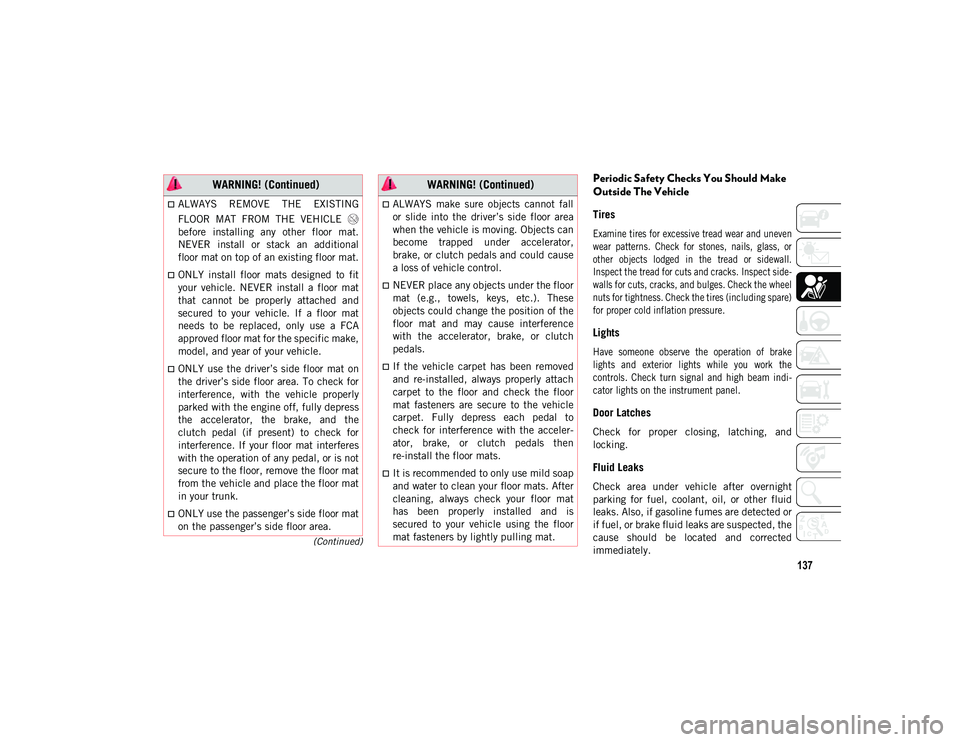
137
(Continued)
Periodic Safety Checks You Should Make
Outside The Vehicle
Tires
Examine tires for excessive tread wear and uneven
wear patterns. Check for stones, nails, glass, or
other objects lodged in the tread or sidewall.
Inspect the tread for cuts and cracks. Inspect side-
walls for cuts, cracks, and bulges. Check the wheel
nuts for tightness. Check the tires (including spare)
for proper cold inflation pressure.
Lights
Have someone observe the operation of brake
lights and exterior lights while you work the
controls. Check turn signal and high beam indi -
cator lights on the instrument panel.
Door Latches
Check for proper closing, latching, and
locking.
Fluid Leaks
Check area under vehicle after overnight
parking for fuel, coolant, oil, or other fluid
leaks. Also, if gasoline fumes are detected or
if fuel, or brake fluid leaks are suspected, the
cause should be located and corrected
immediately.
’ü»ALWAYS REMOVE THE EXISTING
FLOOR MAT FROM THE VEHICLE
before installing any other floor mat.
NEVER install or stack an additional
floor mat on top of an existing floor mat.
’ü»ONLY install floor mats designed to fit
your vehicle. NEVER install a floor mat
that cannot be properly attached and
secured to your vehicle. If a floor mat
needs to be replaced, only use a FCA
approved floor mat for the specific make,
model, and year of your vehicle.
’ü»ONLY use the driverŌĆÖs side floor mat on
the driverŌĆÖs side floor area. To check for
interference, with the vehicle properly
parked with the engine off, fully depress
the accelerator, the brake, and the
clutch pedal (if present) to check for
interference. If your floor mat interferes
with the operation of any pedal, or is not
secure to the floor, remove the floor mat
from the vehicle and place the floor mat
in your trunk.
’ü»ONLY use the passengerŌĆÖs side floor mat
on the passengerŌĆÖs side floor area.
WARNING! (Continued)
’ü»ALWAYS make sure objects cannot fall
or slide into the driverŌĆÖs side floor area
when the vehicle is moving. Objects can
become trapped under accelerator,
brake, or clutch pedals and could cause
a loss of vehicle control.
’ü»NEVER place any objects under the floor
mat (e.g., towels, keys, etc.). These
objects could change the position of the
floor mat and may cause interference
with the accelerator, brake, or clutch
pedals.
’ü»If the vehicle carpet has been removed
and re-installed, always properly attach
carpet to the floor and check the floor
mat fasteners are secure to the vehicle
carpet. Fully depress each pedal to
check for interference with the acceler -
ator, brake, or clutch pedals then
re-install the floor mats.
’ü»It is recommended to only use mild soap
and water to clean your floor mats. After
cleaning, always check your floor mat
has been properly installed and is
secured to your vehicle using the floor
mat fasteners by lightly pulling mat.
WARNING! (Continued)
2020_JEEP_JL_WRANGLER_UG_RHD_UK.book Page 137
Page 140 of 330
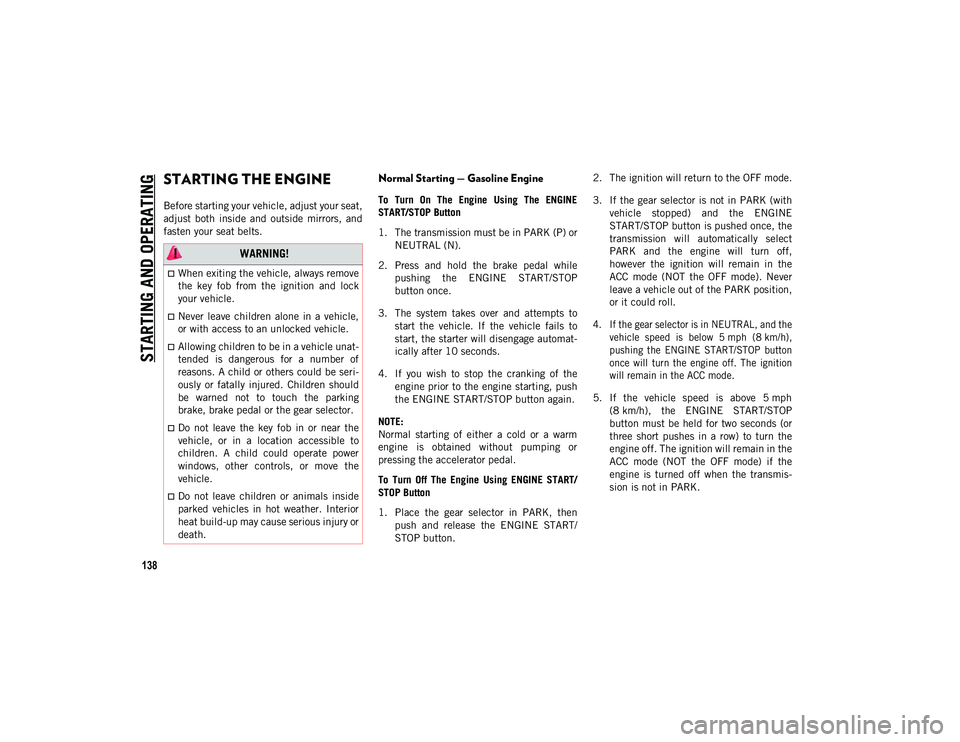
138
STARTING AND OPERATING
STARTING THE ENGINE
Before starting your vehicle, adjust your seat,
adjust both inside and outside mirrors, and
fasten your seat belts.
Normal Starting ŌĆö Gasoline Engine
To Turn On The Engine Using The ENGINE
START/STOP Button
1. The transmission must be in PARK (P) orNEUTRAL (N).
2. Press and hold the brake pedal while pushing the ENGINE START/STOP
button once.
3. The system takes over and attempts to start the vehicle. If the vehicle fails to
start, the starter will disengage automat -
ically after 10 seconds.
4. If you wish to stop the cranking of the engine prior to the engine starting, push
the ENGINE START/STOP button again.
NOTE:
Normal starting of either a cold or a warm
engine is obtained without pumping or
pressing the accelerator pedal.
To Turn Off The Engine Using ENGINE START/
STOP Button
1. Place the gear selector in PARK, then push and release the ENGINE START/
STOP button. 2. The ignition will return to the OFF mode.
3. If the gear selector is not in PARK (with
vehicle stopped) and the ENGINE
START/STOP button is pushed once, the
transmission will automatically select
PARK and the engine will turn off,
however the ignition will remain in the
ACC mode (NOT the OFF mode). Never
leave a vehicle out of the PARK position,
or it could roll.
4. If the gear selector is in NEUTRAL, and the vehicle speed is below 5 mph (8 km/h),
pushing the ENGINE START/STOP button
once will turn the engine off. The ignition
will remain in the ACC mode.
5. If the vehicle speed is above 5 mph (8 km/h), the ENGINE START/STOP
button must be held for two seconds (or
three short pushes in a row) to turn the
engine off. The ignition will remain in the
ACC mode (NOT the OFF mode) if the
engine is turned off when the transmis -
sion is not in PARK.
WARNING!
’ü»When exiting the vehicle, always remove
the key fob from the ignition and lock
your vehicle.
’ü»Never leave children alone in a vehicle,
or with access to an unlocked vehicle.
’ü»Allowing children to be in a vehicle unat -
tended is dangerous for a number of
reasons. A child or others could be seri -
ously or fatally injured. Children should
be warned not to touch the parking
brake, brake pedal or the gear selector.
’ü»Do not leave the key fob in or near the
vehicle, or in a location accessible to
children. A child could operate power
windows, other controls, or move the
vehicle.
’ü»Do not leave children or animals inside
parked vehicles in hot weather. Interior
heat build-up may cause serious injury or
death.
2020_JEEP_JL_WRANGLER_UG_RHD_UK.book Page 138